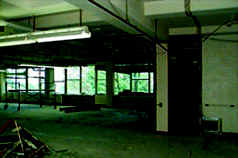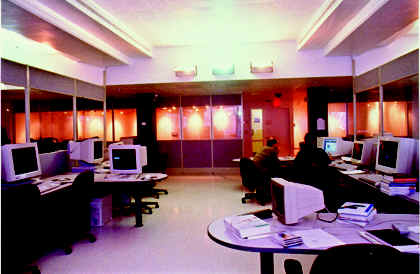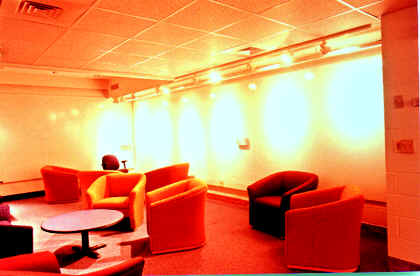
PeopleSoft Information Technology Lab (Systems Lab)
| Just in time for the fall 1997 semester, the majority
of the systems graduate students moved into a new laboratory on the 3rd floor of Upson.
The 3,350 sq. ft. lab, built with a gift from David Duffield, was completely renovated
over the course of the summer of 1997 to the specifications of the faculty whose research
groups would "live" in the lab. Cinder block walls were torn out, asbestos tiles
were lifted from the floor, and a real spaghetti knot of ventilation ducts, chilled |
 |
 |
water pipes, and electric wires was
removed. The first photo shows the mostly gutted area, looking west, with the wall on the
right dividing the bathrooms and elevator shafts. The new lab
brings together a number of groups in the Department that are working on topics related to
information technology: from networking to extensible server systems to multimedia and
computer vision. We wanted to provide an open work environment where students work
comfortably but easily turn around and ask questions of others or simply |
| observe what exciting things are happening
in other groups. Toward this goal, we designed the lab to have private areas for each
group, but used glass partitions to maintain the feeling of a single large lab. The photo
below shows the lab from the entrance area. To the right are three "bays"
separated by glass partitions. Each bay is occupied by two research groups. Toward
the inside of the lab, a number of rooms complement the bays. A machine room houses
the network switches |
|
 |
| and the noisy server machines, such as the 100GB NT
file server. Two discussion areas, shown in the third photo, are paneled with whiteboards
and have comfortable seats for meetings. A small "dirt room" has tools for wood
and metal working, as well as for hardware development. The entrance to the lab has a
small kitchen to keep the sodas and caffeine flowing as well as reheat pizzas at 2am. The
lab is well furnished with computer hardware and assorted toys. There are 40-50 Pentium
Pro, Pentium II, and dual-Pentium II PCs, most with 21" monitors and all on the lab's
switched fast Ethernet. Many PCs have video conferencing cameras. An omnidirectional
camera and several remotely controllable cameras hang from the ceiling (see
http://www3.cs.cornell.edu/webcam for a live picture of the lab). The main discussion area
has an XGA projection screen. The server room holds three quad Pentium Pro servers and
close to 200GB of disk space. In addition, the lab has its own telephone switch (PBX)
which is connected to the Cornell telephone network with a T1 line |
 |
Currently, the research groups of D.
Huttenlocher, R. Zabih, S. Keshav, B. Smith, W. Vogels, and T. von Eicken are located in
the lab. About 30 PhD students and 20-30 undergraduates and Master of Engineering students
are involved. In its first year, the idea of the lab has really panned out: many students
are far more aware of the research going on around them. The
"cross-fertilization" buzzword for once accurately describes what is
happening. Another benefit of the new lab is that new students can easily integrate into a
group and get "jump-started" with research. |
| This is of particular importance for
undergraduates getting involved in research, who have a shorter time-horizon for projects
and who typically need more support to get started. In the new lab, there is always
someone around to ask. |
|





